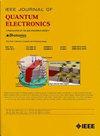Numerical Modeling for 250 nm DUV LEDs With Discrete p-type Functional Layers to Manage Both Carrier and Photon Transport
IF 2.1
3区 工程技术
Q3 ENGINEERING, ELECTRICAL & ELECTRONIC
引用次数: 0
Abstract
Deep-ultraviolet light-emitting diodes (DUV LEDs) are encountering low external quantum efficiency (EQE) and light output power (LOP) due to the strong optical absorption to DUV light and the poor carrier injection efficiency. To solve these issues, we design and optimize a 250 nm DUV LED structure with thin quantum wells and discrete p-type functional layers. The discrete p-type functional layers consist of a high Al composition-gradient layer (layer I) and a low Al composition-gradient layer (layer II). Calculated results indicate that the use of thin quantum wells can rearrange the valence subband distributions to increase the transverse-electric (TE) polarized emission, thereby enhancing light extraction efficiency (LEE). Additionally, the LEE can also be increased by optimizing the thickness of the discrete p-type functional layers, i.e., modulating the optical absorption effect and the optical cavity effect. Meanwhile, we also investigate the impact of different negative polarization bulk charge densities on the electron and hole injections by changing the thickness of layer I and layer II, which can obtain the optimized internal quantum efficiency (IQE) for the 250 nm DUV LED. Therefore, when compared with conventional DUV LEDs, the proposed LED architectures improve the EQE and optical power if the discrete p-type functional layers are properly designed.利用离散 p 型功能层管理载流子和光子传输的 250 nm DUV LED 数值建模
深紫外发光二极管(DUV LED)的外部量子效率(EQE)和光输出功率(LOP)较低,这是由于 DUV 光的光吸收强和载流子注入效率低造成的。为了解决这些问题,我们设计并优化了具有薄量子阱和分立 p 型功能层的 250 nm DUV LED 结构。分立 p 型功能层由高铝成分梯度层(层 I)和低铝成分梯度层(层 II)组成。计算结果表明,使用薄量子阱可以重新排列价子带分布,增加横电(TE)极化发射,从而提高光萃取效率(LEE)。此外,还可以通过优化分立 p 型功能层的厚度,即调节光吸收效应和光腔效应来提高萃光效率。同时,我们还通过改变层 I 和层 II 的厚度,研究了不同负极化体电荷密度对电子和空穴注入的影响,从而获得了 250 nm DUV LED 的优化内部量子效率(IQE)。因此,与传统的 DUV LED 相比,如果分立 p 型功能层设计得当,所提出的 LED 架构可提高 EQE 和光功率。
本文章由计算机程序翻译,如有差异,请以英文原文为准。
求助全文
约1分钟内获得全文
求助全文
来源期刊

IEEE Journal of Quantum Electronics
工程技术-工程:电子与电气
CiteScore
4.70
自引率
4.00%
发文量
99
审稿时长
3.0 months
期刊介绍:
The IEEE Journal of Quantum Electronics is dedicated to the publication of manuscripts reporting novel experimental or theoretical results in the broad field of the science and technology of quantum electronics. The Journal comprises original contributions, both regular papers and letters, describing significant advances in the understanding of quantum electronics phenomena or the demonstration of new devices, systems, or applications. Manuscripts reporting new developments in systems and applications must emphasize quantum electronics principles or devices. The scope of JQE encompasses the generation, propagation, detection, and application of coherent electromagnetic radiation having wavelengths below one millimeter (i.e., in the submillimeter, infrared, visible, ultraviolet, etc., regions). Whether the focus of a manuscript is a quantum-electronic device or phenomenon, the critical factor in the editorial review of a manuscript is the potential impact of the results presented on continuing research in the field or on advancing the technological base of quantum electronics.
 求助内容:
求助内容: 应助结果提醒方式:
应助结果提醒方式:


